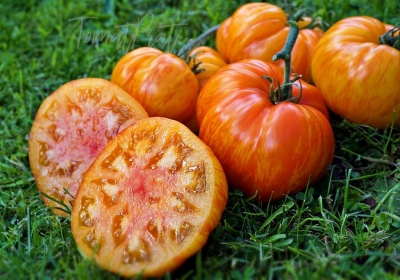
- Authors: Remy Orlowski, Buffalo, Niagara, USA
- Appeared when crossing: obtained by random pollination
- Name synonyms: Plan 9 From Outer Space
- Category: grade
- Growth type: indeterminate
- Appointment: fresh consumption
- Ripening period: mid-season
- Growing conditions: for open ground, for greenhouses
- Bush size: tall
- Bush height, cm: 160-180
Tomato Plan 9 from outer space is named after the science-fiction film of the same name and is as unusual as its appearance. The amazing variety became a stable result of accidental pollination and with its appearance surprised an amateur breeder, a blogger from the United States, Niagara. Remi Orlowski, accidentally growing a new tomato species from Solar Flare seeds on her plot, decided to give it a new exotic name.
Description of the variety
Fancy fruits with stripes of three colors - yellow, orange and red, reach significant sizes and are very tasty when eaten fresh. The bushes grow well in the greenhouse and in the open field, reaching a growth of 2 meters. The indeterminate type of bushes feels good when tied to trellises. The trunk of the plant is strong and thick, and the dark green leaves are no different from all types of tomatoes.
The main qualities of the fruit
The rounded, slightly flattened and large fruits of the Plan 9 tomato from outer space, indeed, resemble a solar flare in color. Red strokes and stripes are randomly distributed over a bright orange-yellow background. Tomatoes, growing on strong and tall bushes, reach a weight of 400 to 600 g. The inside of the fruit is low-seeded, fleshy, mostly orange in color, with a few reddish specks.
Taste characteristics
Exotic tomatoes taste sweet and pleasant. There is almost no acid in them, and the characteristic aroma of tomatoes is well felt when used in the form of salads and juices. The appearance of a slight sourness is noted in those cases when more cloudy days fall for the ripening period, or the bushes were planted in too thick shade.
Ripening and fruiting
When growing tomato bushes in one, maximum two trunks, 2-3 fruits are left in each brush. Fruiting of a mid-season variety usually stretches until autumn. Tomatoes grow on the upper clusters of the same weight as on the lower ones, which is rare in other varieties.
Yield
Subject to the necessary agrotechnical care and timely application of fertilizing during the growing season from one tomato bush Plan 9 from open space, you can collect from 3.5 kg of large and juicy fruits. You can count on a large harvest with regular and timely watering so that the bushes do not lose a large number of ovaries.
The timing of planting seedlings and planting in the ground
Since the Plan 9 variety from outer space appeared naturally, its seeds can be harvested from tomatoes grown on their site and sown in subsequent years. In early March, tomato seed can be sown on seedlings in a soil mixture consisting of garden soil, humus, peat, with the addition of sand and a small amount of wood ash. Before planting, the seeds are usually soaked in a solution of potassium permanganate and biostimulants. Germination of seedlings is carried out in room conditions at an average temperature of about 20 degrees and sufficient illumination. After the development of the second true leaf, the seedlings can be transplanted into a greenhouse or open ground, depending on the climatic characteristics of the region.When growing tomatoes directly in the garden, it is necessary to sow seeds for seedlings about 2 months before transplanting to a permanent place.

Growing tomato seedlings is an extremely important process, because it largely depends on whether the gardener will be able to harvest at all. All aspects must be taken into account, from seedbed preparation to planting in the ground.
Landing scheme
When planting tomatoes in a greenhouse, choose the sunny side to get the best tasting crop. There are 3-4 tall bushes on 1 square meter, tied to vertical supports. So that the plants do not obscure each other from the sun, it is better to plant them in two rows and in a checkerboard pattern.

Growing and care
The area where it is supposed to grow tomatoes of the exotic variety Plan 9 from outer space must be well dug up, weeds removed and compost fertilized. In order for tomatoes to grow with the weight and taste characteristic of their varietal characteristics, they must be watered as the soil dries, and regular abundant watering should be carried out at least 1 time per week. The fruits are resistant to cracking, so the excess moisture content in the ground is not scary for them. During the growing season, you can add complex fertilizers, sometimes watered with a pink solution of potassium permanganate. You can spray the bushes in the flowering phase, but in general the variety is resistant to characteristic diseases.




A plant needs different micronutrients at each stage of growth. All fertilizers can be divided into two groups: mineral and organic. Folk remedies are often used: iodine, yeast, bird droppings, eggshells.
It is important to observe the rate and period of feeding. This also applies to folk remedies and organic fertilizers.



























































































